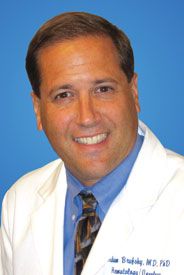Article
Biosimilars Enter US Market, Poised to Impact Cancer Treatment
Author(s):
Adam M. Brufsky, MD, PhD, FACP, discusses the emergence of biosimilars in oncology and how he anticipates they will change the paradigm.
Adam M. Brufsky, MD, PhD, medical director of the MageeWomen's Cancer Program at the University of Pittsburgh Medical Center Hillman Cancer Center

Adam M. Brufsky, MD, PhD
As biosimilars for bevacizumab (Avastin), rituximab (Rituxan), and trastuzumab (Herceptin) enter clinical practice, patients across a number of cancers will soon likely receive biosimilars rather than originator drugs—a move that will likely be enforced by payers, explained Adam M. Brufsky, MD, PhD, FACP.
In January 2020, Pfizer announced that 3 biosimilars—bevacizumab-bvzr (Zirabev), rituximab-pvvr (Ruxience), and trastuzumab-qyyp (Trazimera)—are becoming available in the United States at a significant discount to their reference products, respectively.
“These [biosimilar] drugs will work like the originator. It will be very surprising if they don’t,” said Brufsky, who serves as a professor of medicine, and associate division chief for the Division of Hematology/Oncology, Department of Medicine, at the University of Pittsburgh School of Medicine.
With the availability of biosimilars in US practice, insurance companies will begin incorporating biosimilars into their policies, potentially offering to cover certain biosimilars but not the reference drugs, Brufsky explained. However, as this is a new frontier, only time will tell how biosimilars truly impact clinical practice.
In his own practice, Brufsky anticipates prescribing biosimilars to new patients, but said he will keep patients on the reference product if they are currently being treated with it.
In an interview with OncLive, Brufsky discussed the emergence of biosimilars in oncology and how he anticipates they will change the paradigm.
OncLive: It was recently announced that biosimilars for bevacizumab, rituximab, and trastuzumab will become available in the United States at a significant discount. How will this impact treatment decisions?
Brufsky: Most of us will probably use the biosimilar. It's going to be imposed on us by the various health systems we work for. Generally, the feeling is [that biosimilars] will cost 25% to 30% less than the originator molecule. I personally won't substitute people who are already on the [originator] drug [with a biosimilar], but I will recommend the trastuzumab biosimilar, in my case, to new patients.
What is your reasoning for continuing the originator drug on current patients?
You don't want to mess up; God forbid they relapse. You don't want to say, "I'm sorry. You relapsed." [Choosing to keep current patients on the original drug] has no real rationale, but on the other hand, it is what it is.
Some experts predict that insurance companies will shift coverage to biosimilars rather than the originator drug. What are your thoughts on this?
I don't think insurance companies will force people who are already on [the originator drug] to switch to biosimilars. [The biosimilar] is going to be for new patients because it would be very difficult for insurers to allow us to [switch] people in the middle of therapy. I don't think they're going to interrupt that; I would be very surprised if they do.
Experts also suggest that insurance companies may each cover different biosimilars. How will this impact practice?
[Insurance companies will choose biosimilars] probably based on the deal that they have with [pharmaceutical companies]. It's going to be very complicated for us. I don't know how that's going to work, to be honest. We are going to have to wait and see.
Why do you think there continues to be with hesitation with biosimilars in the United States?
People want to be sure that they have something that's as successful as the original, such as trastuzumab. You really want to be sure that it's not really going to harm anybody.
What advice do you have for other physicians as biosimilars enter clinical practice?
The FDA requires [biosimilars] to be at least bioidentical [to the originators]. They have to have the same biological characteristics in terms of variety of glycosylation patterns, biological structure, and they also have to have the same efficacy within a 95% confidence interval. They have to, by law, be the same drug.
Do you have any advice for physicians on how to talk to patients about biosimilars?
[Tell patients] that it's the same drug. [Biosimilars] are very similar to generics; it helps patients understand [biosimilars] in those terms.
What is the status of physician education for biosimilars in oncology?
There really needs to be physician education, and there will be. Physicians have a lot to engage patients with now, but we need to inform people that biosimilars are important and are the same [as the originators]. We need to make sure physicians are comfortable with the fact that [biosimilars], by law, have to be the same.
[Biosimilars will be able to be used in] other countries where the originator drug is very expensive. They're going to drive down the cost, which is great.
Pfizer brings three new biosimilars to US patients at substantial discounts [news release]. Pfizer Inc. Published January 23, 2020. go.aws/2GjTwYg. Accessed January 29, 2020.








